02.15.11
Posted in Non-US Weather, Weather News, Winter Weather at 8:00 am by Rebekah
This week’s post in the global weather and climate series features Gangneung (Kangnŭng), Gangwon-do, South Korea.
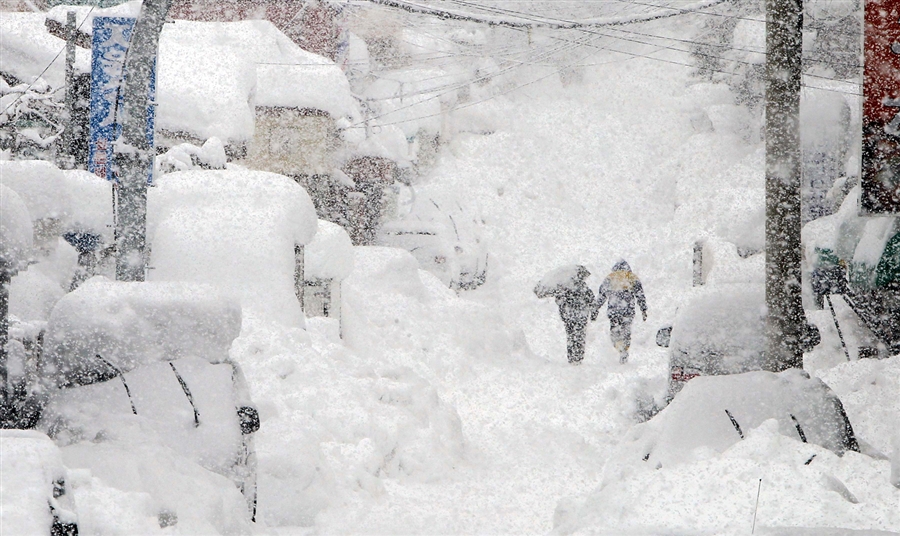
Heavy snow in Gangneung on Feb. 14, 2011. Photo by Lee Sang-hak / Yonhap via Reuters
Gangneung (Kangnŭng) is a city of about 230,000 people in Gangwon-do province, South Korea. Situated on the east coast of the country, Gangneung lies between the Sea of Japan (East Sea) and the Baekdu mountain ridge. The beautiful valleys and mountains around Gangneung, as well as the pine forests and sandy beaches, make this city a popular tourist destination. There are also many festivals that take place in Gangneung.
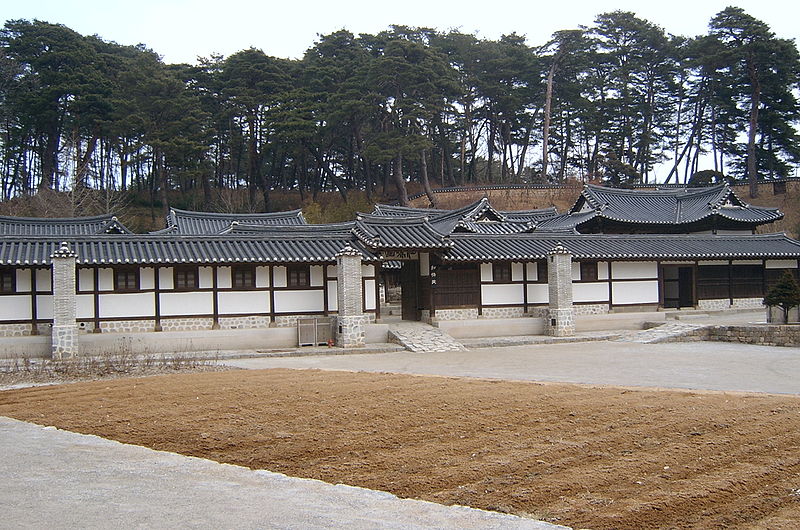
Seongyojang, a 19th century country house outside of Gangneung. From Wikipedia
A few more facts about Gangneung (from Wikipedia):
- Time zone: Korea Standard Time (UTC+9)
- Elevation: varies…from about 30 ft (9 m) to around 100 ft (30 m)…higher in the hills
- Climate zone: Humid subtropical
- Average high temperature: 63 °F (17 °C)
- Average low temperature: 48 °F (9 °C)
- Average annual high/low temperature range: 41 to 83 °F (5 to 28 °C) / 26 to 70 °F (-3 to 21 °C)
- Average annual precipitation: 55 inches (1,402 mm)
Weather: Eastern South Korea has been experiencing record snowfalls lately. Gangneung recently observed a 24-hr snowfall of 30.6 inches (77.7 cm), the greatest 24-hr snowfall since records began in 1911. This heavy snow caused hundreds of roofs to collapse and stranded cars in huge drifts of snow.
High temperatures this week are expected to be in the mid to upper 30s (°F), with lows around 20 °F. Snow is not uncommon this time of year, but this has been an uncommonly cold winter for North Korea and snowy winter for eastern South Korea. Newspapers in South Korea are calling this a “snow bomb”, similar to recent US terms popularized by the media such as “snowpocalypse” and “snowmaggedon”.
For weather maps and information on current and forecast Gangneung weather, see Weather Underground and Weather Online UK (maps and models).
For more information on Gangneung, here’s a link to Wikipedia.
Next Tuesday I plan to take a look at the climate and weather in another part of the globe. As always, if you have any suggestions for future cities, please leave a comment!
Permalink
02.14.11
Posted in Weather Education at 8:00 am by Rebekah
Today’s post in the weather education series is on precipitation, one of the seven elements of weather (temperature, pressure, wind, moisture, clouds, precipitation, and visibility).
————————————————–
Last week we looked at clouds, including what they’re made of, how they form, and the different types. We said that clouds form when water vapor condenses/deposits on tiny particles (e.g., dust, smoke, salt) called cloud condensation nuclei / ice nuclei.
When those water droplets or ice crystals grow large enough, they will begin to fall out of the cloud.
Types of Precipitation
- Falling water droplet + other water droplets = coalescense, leading to rain
- Falling ice crystal + supercooled water droplets (liquid water existing below 0 °C or 32 °F) = accretion, leading to graupel (< 3 to 4 mm)…if the graupel gets lofted up in the cloud (more on this later), it may continue to collect water droplets and we will get hail
- Falling ice crystal + other ice crystals = aggregation, leading to snowflakes
- If the lowest layer of the atmosphere is warm enough (above 0 °C) and thick enough, the snowflakes can melt and will just fall as rain
- If there is a thick warm layer (above 0 °C) above a thin cold layer above the ground, the snow will melt but the raindrops will become supercooled, and you will get freezing rain as the liquid water freezes on contact with the ground
- If there is a thin warm layer (above 0 °C) above a cold layer above the ground, the snow will partially melt but then refreeze before hitting the ground as sleet
More info and illustrations on the temperature profiles needed for winter precipitation will come later in the series.
————————————————–
The final element of weather is visibility, but we will not treat this separately as it is dependent on other elements such as precipitation.
Next Monday we will move on to time zones!
Permalink
02.13.11
Posted in Non-US Weather, Tropical Weather, Weather News at 1:20 pm by Rebekah
Intense Tropical Cyclone Bingiza (see southwest Indian Ocean ratings) now has 10-minute average sustained winds of 105 mph and a minimum pressure of 953 mb (equivalent of a Category 3 on the Saffir-Simpson Scale). The tropical cyclone is still slowly moving towards northeastern Madagascar at 5 mph, and is expected to now in about 24 hours (late Monday night local time).
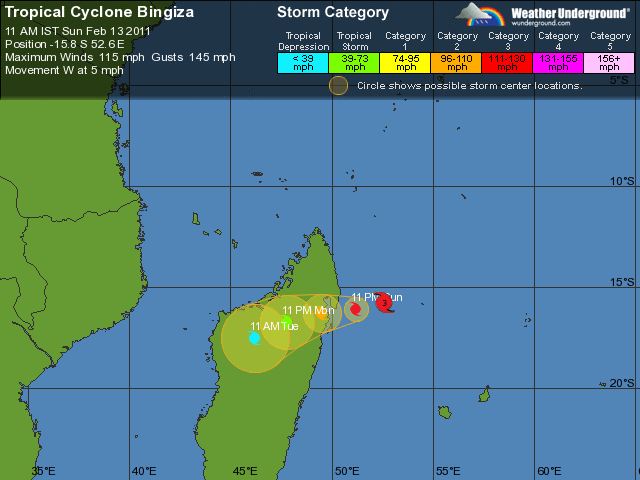
Forecast track of Tropical Cyclone Bingiza, from Weather Underground
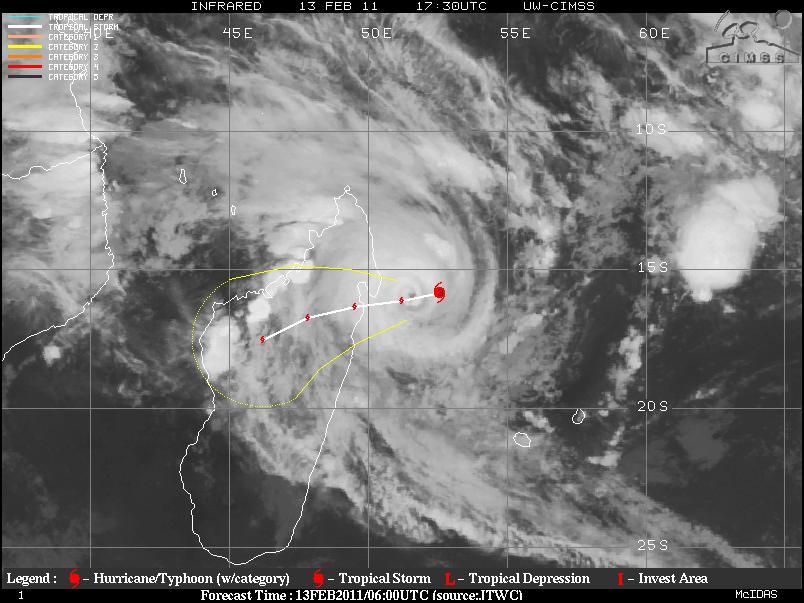
Tropical Cyclone Bingiza, from UW-CIMSS
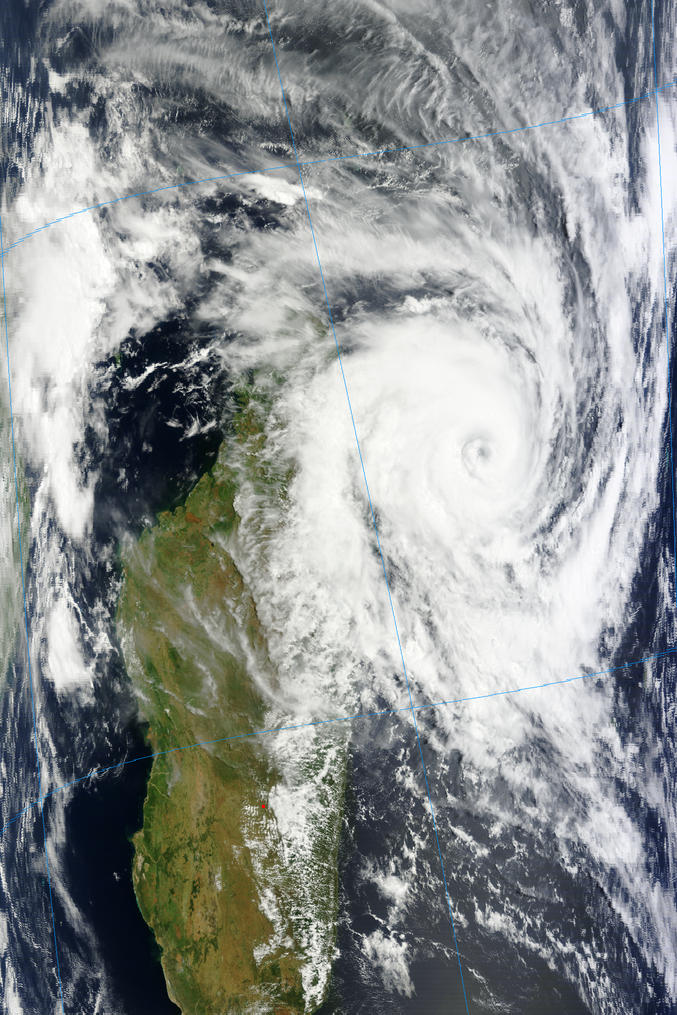
Tropical Cyclone Bingiza, from Terra/MODIS
The tropical cyclone is still headed for the farming towns of Manambolosy, Mananara Nord, and Soanierana Ivongo, as well as affect a tiny, offshore island called Île Sainte-Marie.
See also the post earlier today on Bingiza.
Permalink
Posted in Non-US Weather, Tropical Weather, Weather News at 8:00 am by Rebekah
Tropical Cyclone Bingiza, with 10-minute average sustained winds of 90 mph and a minimum pressure of 963 mb (equivalent of a Category 2 on the Saffir-Simpson Scale), is slowly inching its way towards northeastern Madagascar. The tropical cyclone is currently moving west-southwest at 3 mph.
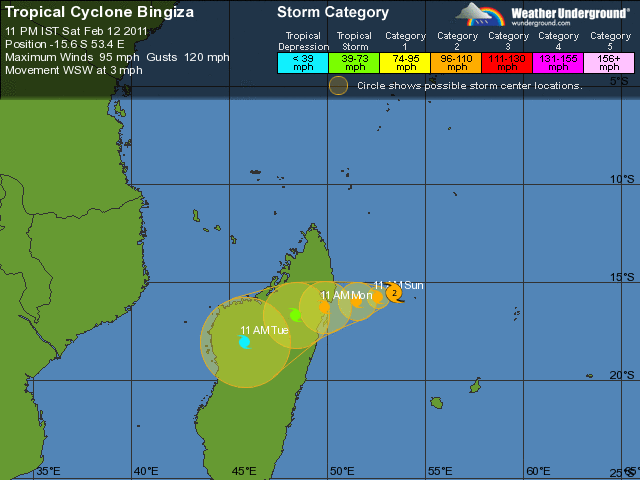
Forecast track of Tropical Cyclone Bingiza, from Weather Underground
The cyclone is expected to make landfall at about this intensity late Monday morning local time (Sunday night U.S. time).
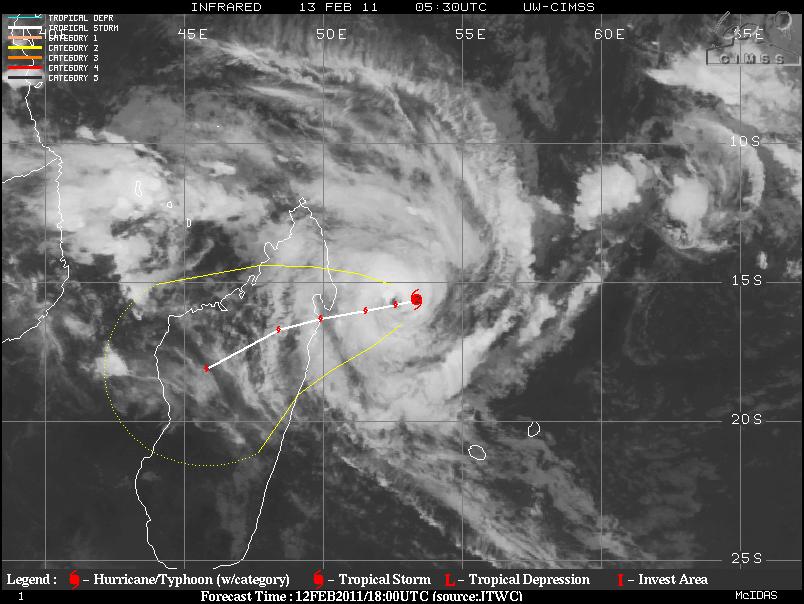
Tropical Cyclone Bingiza, from UW-CIMSS
It appears that the cyclone’s eye will make landfall near the farming towns of Manambolosy (~11,000 people), Mananara Nord (~30,000), and Soanierana Ivongo (~22,000), as well as affect a tiny, offshore island called Île Sainte-Marie (~17,000).
Madagascar is no stranger to tropical cyclones. The southwest Indian Ocean’s most intense cyclone in recorded history struck this same part of Madagascar in March 2004, causing devastating damage. Cyclone Gafilo was the equivalent of a Category 5 on the Saffir-Simpson Scale, with a minimum central pressure of 895 mb and 10-minute sustained winds of 145 mph (1-minute sustained winds of 160 mph).
To see more on different tropical cyclone rating systems in different ocean basins, see another blog post I wrote, “Tropical Cyclone Ului Makes Landfall in Australia“.
To see a recent blog post I wrote on the weather and climate of the nearby capital of Madagascar, Antananarivo, check out “World Wide Weather #25: Antananarivo, Madagascar“.
Bingiza is the fifth tropical disturbance and the second named storm of the Southwest Indian Ocean tropical cyclone season, which begun on November 15th and will run until April 30th.
Permalink
02.12.11
Posted in Weather News at 8:00 am by Rebekah
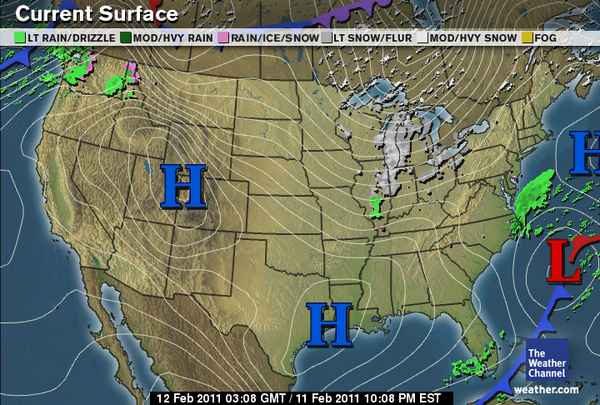
Weather across the U.S. is pretty tranquil this weekend, but we soon expect a pattern change that will bring warmer temperatures and a chance for thunderstorms to the Southern Plains.
Central Oklahoma will likely reach 80 °F this week; a far cry from the sub-zero temperatures this past week.
By the end of this coming week, models are showing the western ridge will break down and we’ll see a more progressive pattern with shortwave troughs digging into the Southwest. It also looks like the dewpoints will start to rise by the end of the week, and although we should get a few more fronts that will lower the dewpoints again, it certainly appears that the Southern Plains anyway is done with winter and we’ll soon be on to storm season!
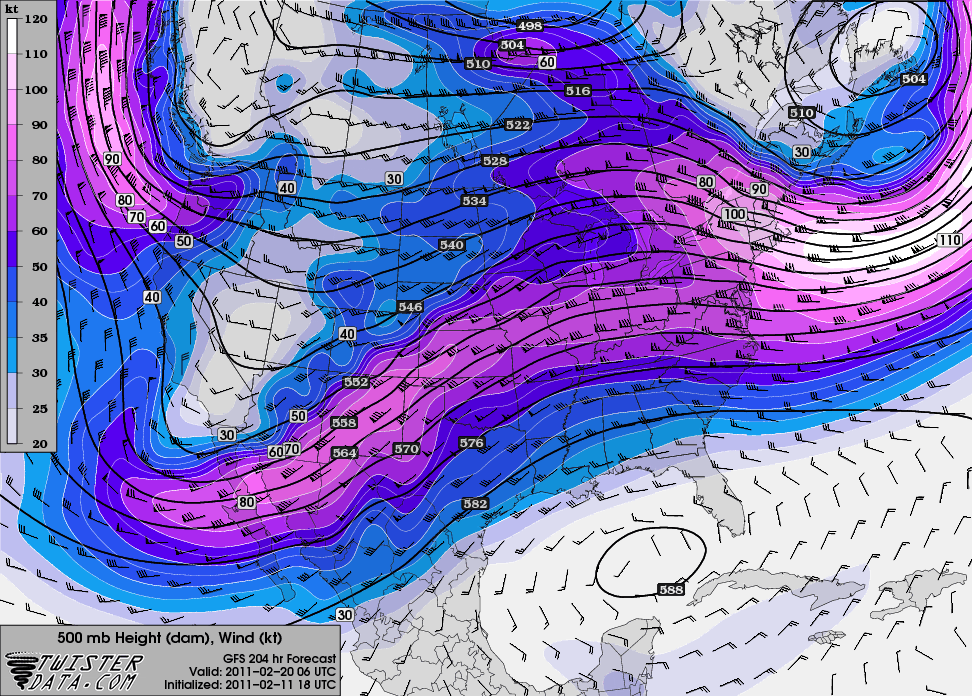
500 mb GFS forecast for next Saturday, from Twister Data
Permalink
« Previous Page — « Previous entries « Previous Page · Next Page » Next entries » — Next Page »








